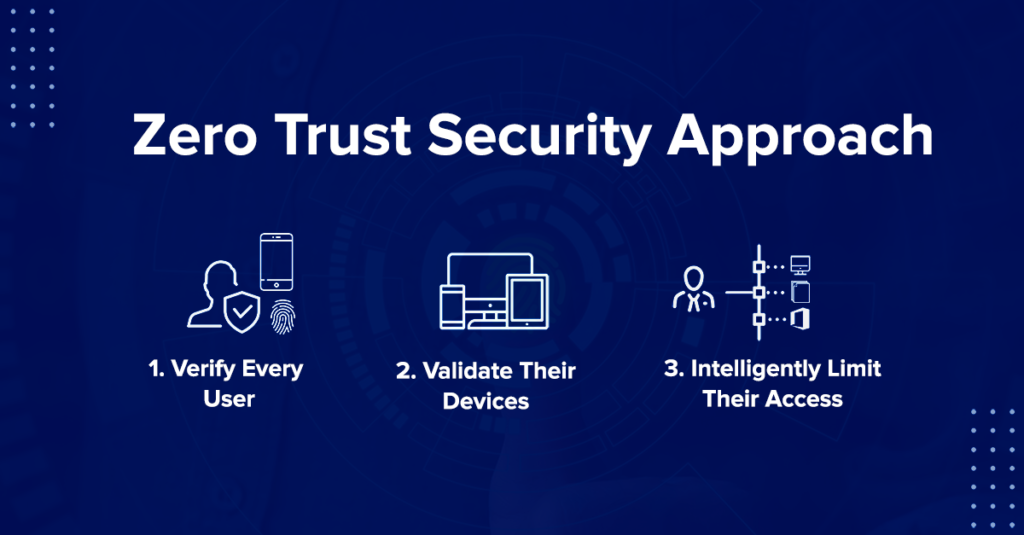What is Zero Trust?
The Zero Trust is a cybersecurity framework that challenges the conventional network safety philosophy of implicitly trusting network administrators and users. It runs under the belief of “never trust, always verify,” which states that no user or device should ever be presumed to be trustworthy, irrespective of their location or network connection.
Zero Trust is based on the premise that there is no such thing as a conventional network edge and that networks can be local, in the cloud, hybrid, or a combination of both, with people and resources spread around the globe.

What is Zero Trust Model?
In 2010, Forrester Research analyst John Kindervag offered a concept dubbed “Zero Trust.” The approach of “trust but verify” was changed to “never trust, always verify.” No person or device is trusted to access a resource under the Zero Trust paradigm until their identity and authorisation are confirmed. This strategy acknowledges that both internal and external networks might be hacked, and it advises organisations to take a more context-sensitive, holistic approach to protection.
The present condition of remote employment stands in sharp contrast to the conventional castle-and-moat method of cybersecurity. Users and apps are now equally likely to be outside the moat as they are inside it because of the emergence of the cloud, which has changed the network perimeter. This creates perimeter vulnerabilities that bad actors may take advantage of to access resources and high-value assets or launch an insider attack. The typical approach to remote work has become ineffective.
Key Principles of Zero Trust:
The foundation of the Zero Trust security model is a set of fundamental ideas intended to accurately identify people and their intentions. Zero Trust principles include:
- Never trust the network:
The approach demands a mental adjustment since it acknowledges that the network is hostile by nature. This essential premise necessitates that organisations maintain a constant attitude of suspicion and scepticism.
- Trust No Device
It forces us to embrace a healthy scepticism to acknowledge the network environment’s intrinsic lack of reliability. There is no space for complacency with this strategy since continual verification and validation are required at every stage.
- Least privilege access
To limit the potential harm if a user’s credentials are stolen, users and devices should only be given the minimal degree of access required to do their responsibilities. This strategy differs from “trust everyone inside” or “trust but verify” methods since it minimises interaction between users and delicate network components.
- Divide and Conquer network strategy (Micro segmentation)
Barriers to access are put in place to prevent shifting inside networks by segmenting them into smaller sections or zones. To prevent users from gaining access to multiple zones without further authentication, micro-segmentation divides security settings into smaller areas on distinct sections of the network.
- Reduce risk by eliminating the attack surface:
Strict restrictions on user and device access decrease network attack surfaces. By allowing only the minimum amount of permission required to execute a task, access control should protect critical systems, and monitoring how endpoints access network resources is essential to ensure that each one is approved.
- MFA is mandatory:
Multi-factor authentication is crucial before granting access. MFA is thought to be stronger than two-factor authentication (2FA), which potentially jeopardise zero trust. Data security measures like Transport Layer Security (TLS) are used to guarantee the privacy and authenticity of data while it is in phase and at rest.
Zero Trust model Use Cases:
The Zero Trust Model saves thousands of organisations whose architecture resembles:
- Cloud Mitigation
- A hybrid or remote workforce.
- Privileged access management
- Software-as-a-service apps (SaaS)
Zero Trust framework aims to eliminate these threats:
- Insider Threats
- Malware and Ransomware attacks
- Credential Threats
- Data Breaches
Zero Trust is vital for the organisations that deal with:
- Cloud based infrastructure
- Regulatory concerns or requirements
- Intellectual property
- Sensitive data
In today’s dynamic and linked corporate world, it provides a holistic security strategy that mitigates a wide range of risks. The Zero Trust approach is essential for any company that places a high priority on these concerns.
If you are interested in finding out more about ways to cybersecurity or you are looking to take on an IT provider, contact us here. We currently offer a free IT consultation, so don’t forget to fill out our IT Workplace Assessment, so we can come back to you with our recommendations.